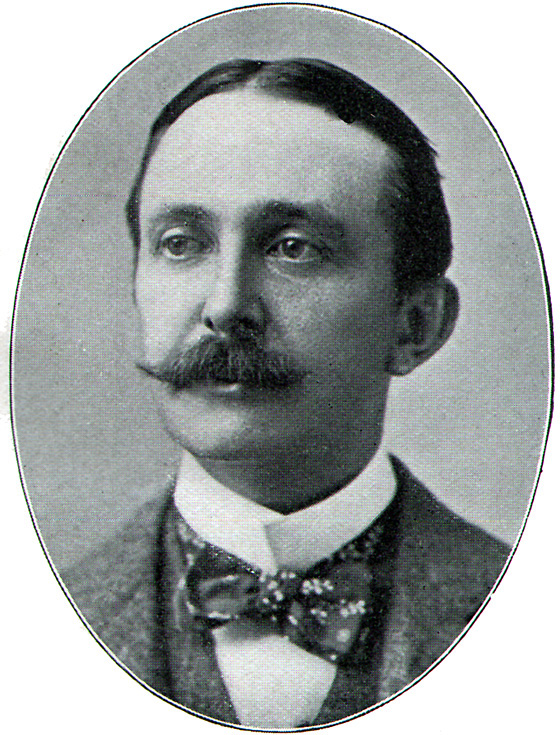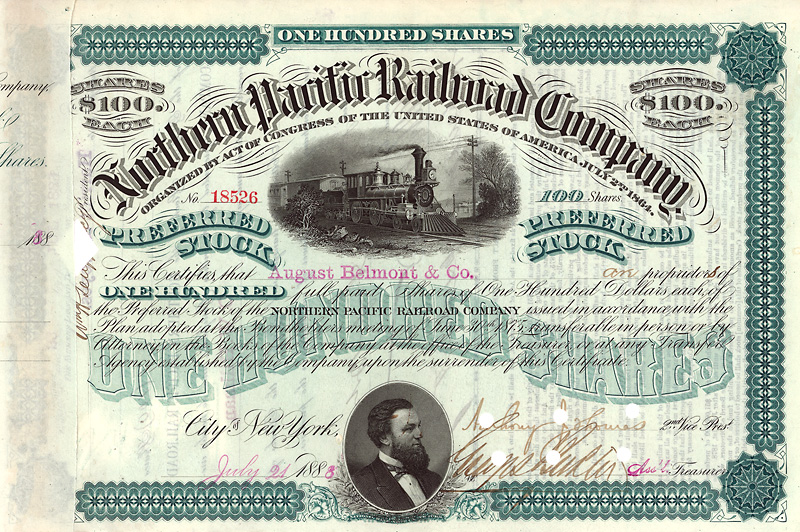|
Business Magnates, Industrialists, Railroad Tycoons, Capitalists, Financiers
|
|
August Belmont Jr.
|
 |
|
August Belmont Junior (1851-1924) war ein amerikanischer Bankier, Pferdezüchter und Besitzer eines Pferderennstalls. Er war Sohn des aus Alzey stammenden Bankiers und Politikers August Belmont, Bruder von Oliver Belmont und Zwillingsbruder von Perry Belmont. 1875 graduierte er an der Harvard University. Nach dem Tode seines Vaters erbte er 1890 einen Teil des Vermögens und übernahm den Vorsitz des Bankhauses August Belmont and Company. Als Präsident der Interborough Rapid Transit Company (IRT) trug er wesentlich zum Bau der New Yorker U-Bahn bei. Belmont ist der einzige Mensch, der jemals einen privaten U-Bahn-Wagen besaß; er nannte ihn Mineola und nutzte ihn für Besichtigungsfahrten auf dem Streckennetz. Wie sein Vater liebte auch August Belmont jr. Pferderennen für Vollblutpferde. Er finanzierte den Bau der 1905 eröffneten Pferderennbahn Belmont Park, auf dem heute noch die Belmont Stakes ausgetragen werden. Außerdem war er Präsident des Jockey Club, Vorsitzender der New York State Racing Commission und Gründungsmitglied der National Steeplechase Association. Belmont besaß über Jahre hinweg einen der besten Pferderennställe; fünf seiner eigenen Pferde gewannen die Belmont Stakes. Er züchtete auch Polo-Ponys und spielte selbst Polo. Zwölf Jahre nach dem Tod seiner ersten Frau Elizabeth Hamilton, geborene Morgan, heiratete er die die britische Schauspielerin Eleanor Robson Belmont, geborene Robson. Nachdem die USA in den Ersten Weltkrieg eingetreten waren, meldete sich Belmont im Alter von 65 Jahren freiwillig und wurde von der United States Army nach Frankreich geschickt, um dort organisatorische Unterstützung zu leisten. Seine zweite Ehefrau nannte zu seinen Ehren ein neugeborenes Fohlen „My Man O'War“ (mein Mann des Krieges). Nach der Rückkehr Ende 1918 beschloss Belmont, seinen Rennstall zu verkaufen und beim Namen des Pferdes das „My“ wegzulassen. Man o' War wurde in den frühen 1920er Jahren eines der erfolgreichsten Rennpferde aller Zeiten. August Belmont trug wesentlich dazu bei, dass der Cape-Cod-Kanal an der engsten Stelle der Halbinsel Cape Cod nach mehreren gescheiterten Anläufen verwirklicht wurde. Doch schon bald nach der Eröffnung am 29. Juli 1914 geriet die Kanalgesellschaft in erhebliche finanzielle Schwierigkeiten. 14 Jahre später wurde der Kanal von der US-Regierung erworben. 1924 starb Belmont auf seinem 440 Hektar großen Anwesen in North Babylon auf Long Island. Seine Witwe verkaufte den größten Teil des Anwesens und starb 1979 im Alter von 100 Jahren. Nach ihrem Tod fiel das restliche 63 Hektar große Grundstück mit der Familienresidenz in den Besitz des Staates New York. Unter der Leitung von Robert Moses wurde das Gelände wieder auf 184 Hektar vergrößert und in den Belmont Lake State Park umgewandelt. |
|
August Belmont, Jr. (1853-1924) was an American financier, the builder of New York's Belmont Park racetrack, and a major owner/breeder of Thoroughbred racehorses. Born in New York City, he was the son of the wealthy banker, August Belmont. An 1875 graduate of Harvard University, where, as a sprinter, he introduced spiked track shoes to the United States. Upon his father's death, he inherited a position as head of the Belmont banking house and served as a Director of the National Park Bank. August Belmont, Jr. founded the Interborough Rapid Transit Company in 1902 to help finance the construction of and operate New York City's first underground rapid transit line. He served as president, and, in 1907, chairman of the company. Belmont holds the distinction of owning the world's only purpose built private subway car. Named Mineola, she was used by Belmont to give tours of the IRT. Following the United States' entry into World War I, August Belmont, Jr., at age 65, volunteered to assist and was sent to France by the United States Army. He received a commission as major in the U. S. flying corps. His wife, Eleanor, also devoted much time to raising funds in aid of Belgian relief efforts and for the Red Cross, she made a number of trans-Atlantic trips as an inspector of United States Army camps. August Belmont was instrumental in making the Cape Cod Canal a reality. Throughout the nineteenth century, many plans were made, but none succeeded. It took Belmont and modern engineering to finally make the pilgrims' dream a reality. The grand opening of the Cape Cod Canal took place on July 29, 1914, and it was soon plagued with troubles. Belmont's canal was expensive for mariners, costing as much as $16.00 for a trip by schooner, a considerable sum in those days. The narrow 140-foot (43 m) width and shallow 25-foot (7.6 m) depth of the canal made navigation difficult, and tidal flows created dangerous currents, so many mariners continued to use the routes around the cape. As a result, tolls did not live up to expectations and the Cape Cod Canal became a losing proposition. As a result, the Canal was purchased by the U.S. Government on March 30, 1928. Like his father, August Belmont, Jr, was an avid thoroughbred racing fan. According to his TIME magazine obituary, August Belmont, Jr. "is credited with having saved thoroughbred racing when it was at its lowest ebb in the East, after the repeal of the racing law in New York State." August Belmont, Jr. served as the first president of The Jockey Club and was chairman of the New York State Racing Commission. In 1895 he was one of the nine founding members of the National Steeplechase Association. August Belmont, Jr. inherited Nursery Stud, a Thoroughbred breeding operation established in 1867 by his father at his 1,100-acre (4.5 km2) Babylon, New York estate. There, Belmont, Jr. raised polo ponies and played on a polo team with Harry Payne Whitney. It was here he stood the Hall of Fame stallion Kentucky. In the early 1880s, Belmont, Sr. leased a farm property in Kentucky, located about three miles outside Lexington. After transferring all of the breeding business there, August Belmont, Jr. developed a very important stud farm whose influences are still felt today. Given the same name as the New York operation, at the Kentucky Nursery Stud he bred 129 American Stakes winners. The greatest of the horses he bred was Man o' War, born while he was serving overseas in World War I. In his absence, his wife Eleanor named the new foal "My Man o' War" in honor of her husband but because of his age and the uncertainty as to the war's end, August Belmont, Jr. decided to disband the stable and with the "My" dropped from the name, Man o' War was sold to Glen Riddle Farm in Maryland. August Belmont, Jr. organized the Westchester Racing Association in 1895. In 1905 he built Belmont Park racetrack in Elmont, on Long Island which operates to this day as the largest thoroughbred racing facility in the state. In the year of its opening, the prestigious Belmont Stakes, inaugurated in 1867 and named in his father's honor, was transferred from the financially troubled Morris Park Racecourse. Three times, horses from August Belmont, Jr.'s stable won the Belmont Stakes, the first coming in 1902 followed by back-to-back wins in 1916 and 1917. Belmont, Jr. also had horses competing in England and in 1908 his American-bred colt Norman III won a British Classic Race, the 2,000 Guineas. In addition to his Kentucky horse farm, in 1908 Belmont established Haras de Villers, a breeding operation near Foucarmont in Upper Normandy, France. Following the cessation of racing in New York State as a result of the Hart-Agnew Law banning parimutuel betting, Belmont, Jr. stood American stallions at Haras de Villers such as Flint Rock, Ethelbert, and the sire of Norman III, Octagon. At his French farm, he bred notable horses such as Prix de Diane winner Qu'elle est Belle as well as Vulcain, one of the best three-year-olds of his generation in France. August Belmont, Jr. operated the Kentucky farm until his death in 1924 after which the business was broken up and its bloodstock sold. According to Thoroughbred Heritage, today the property is home to a condominium development. Its horse cemetery, which became part of Hurstland Farm then the Nuckols Farm, is now occupied by the Rood and Riddle Veterinary Clinic. In 1888, August Belmont, Jr. became the American Kennel Club's fourth President. In 1881, August Belmont, Jr. married childhood sweetheart and next-door neighbor, Elizabeth Hamilton Morgan. She died at age thirty-six while visiting Paris, France in 1898. He planned to marry Alice De Giocouria, but she became ill with typhoid. A widower for twelve years, on February 26, 1910 he married actress Eleanor Robson. August Belmont, Jr. died in 1924, after living much of his life on a 1,100-acre (4.5 km2) estate in North Babylon, New York. He was buried in the Belmont family plot at Island Cemetery in Newport, Rhode Island. After his death, his widow, Eleanor, sold most of the estate to a property developer. Eleanor Belmont outlived her husband by fifty-five years, dying just shy of her 100th birthday in 1979. The remaining 158 acres (0.64 km2), including the family mansion, lake, and main farm buildings, was taken by New York State. Under the control of planner Robert Moses, the estate was enlarged back to 459 acres (1.86 km2) and turned into Belmont Lake State Park. The mansion served as headquarters for the Long Island State Park Commission until 1935 when it was leveled to make way for the current building. |
 |
|
Stock certificate of the Northern Pacific Railrod Company, issued 1888 to the August Belmont & Co., hand signed on the back side by August Belmont, Jr.
|